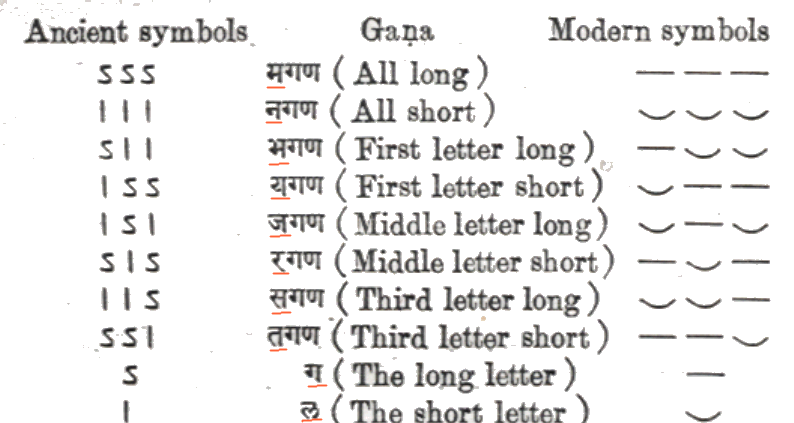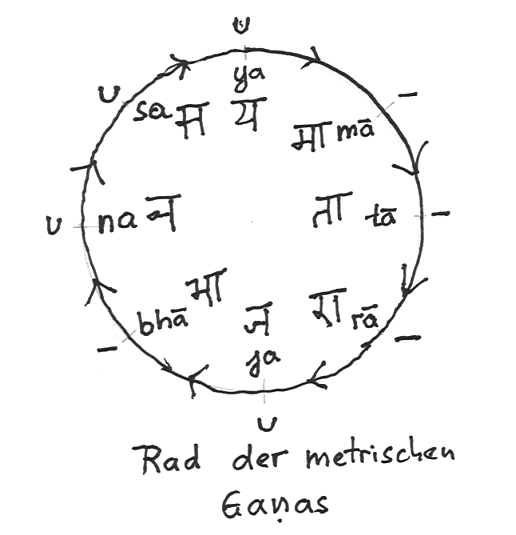

Zitierweise / cite as:
Payer, Alois <1944 - >: Einführung in die Exegese von Sanskrittexten : Skript. -- Kap. 8: Die eigentliche Exegese, Teil II: Zu einzelnen Fragestellungen synchronen Verstehens. -- Anhang B: Zur Metrik von Sanskrittexten. -- Fassung vom 2012-07-02. -- URL: http://www.payer.de/exegese/exeg08b.htm. -- [Stichwort].
Erstmals publiziert: 2004-07-06
Überarbeitungen: 20012-07-02 [Ergänzungen]; 2007-05-03 [Verbesserungen]; 2006-05-18 [Ergänzungen]; 2006-05-11 [Ergänzungen; Umstellung auf Unicode]; 2004-07-26 [Ergänzungen]
Anlass: Lehrveranstaltung Proseminar Indologie WS 1995/96
©opyright: Dieser Text steht der Allgemeinheit zur Verfügung. Eine Verwertung in Publikationen, die über übliche Zitate hinausgeht, bedarf der ausdrücklichen Genehmigung des Verfassers.
Abb.: Christian Morgenstern <1871 - 1914>: Fisches Nachtgesang: das tiefste deutsche Gedicht
"Das Verständlichste an der Sprache ist nicht das Wort selber, sondern der Ton, Stärke, Modulation, Tempo, mit denen eine Reihe von Wörtern gesprochen werden – kurz die Musik hinter den Worten, die Leidenschaft hinter dieser Musik, die Person hinter dieser Leidenschaft: alles das also, was nicht geschrieben werden kann. Deshalb ist es nichts mit Schriftstellerei." [Friedrich Nietzsche <1844 - 1900>, Nachlass Sommer-Herbst 1882]
Abb.: Vaman Shivram Apte
Apte, V. S. (Vaman Shivram) <1858 - 1892>: The practical Sanskrit-English dictionary. -- rev. ed. -- Poona : Prasad, 1957-59 . -- vol.3. -- Appendix A: -- S. 1-2 gibt sehr klar die Grundlagen für die Bestimmung von Sanskritmetren:
"The earliest and most important work in Sanskrit prosody is the Piṅgala-chandas-śāstra, attributed to the sage Piṅgala, which consists of Sūtras distributed over eight books. The Agni-Purāṇa also gives a complete system of prosody founded apparently on Piṅgala's. Several other original treatises have likewise been composed by various authors, such as the Śruta-bodha, Vāṇībhūṣana, Vṛtta-darpaṇa, Vṛtta-ratnākara, Vṛtta-kaumudī, Chandomañjarī &c. In the following pages the Chandomañjarī and Vṛtta-ratnākara have been chiefly drawn upon, Vedic as well as Prākṛta metres being ignored in this Appendix. Sanskrit composition may be in the form
- of gadya 'prose' or
- padya 'verse' or poetry expressed in the form of stanzas.
A stanza or padya is a combination of four pādas or quarters, which are regulated
- either by the number of syllables (akṣara),
- or by the number of syllabic instants (mātrā).
A padya is a vṛtta or jāti.
- A vṛtta is a stanza the metre of which is regulated by the number and position of syllables in each Pāda or quarter.
- A jāti is a stanza the metre of which is regulated by the number of syllabic instants in each quarter.
Vṛttas are divided into three classes:
- samavṛtta in which the Pādas or quarters composing the stanza are all similar;
- ardhasamavṛtta in which the alternate quarters are similar;
- and viṣamaṛtta in which the quarters are all dissimilar.
A syllable is as much of a word as can be pronounced at once, that is, a vowel with or without one or more consonants.
A syllable is
- laghu 'short' or
- guru 'long',
according as its vowel is 'short' or 'long'. The vowels a, i, u, ṛ and ḷ are short; and ā, ī, ū, ṝ, e, ai, o and au are long. But a short vowel becomes long in prosody when it is followed by an Anusvāra or Visarga, or by a conjunct consonant; as the vowel a in gandha or gaḥ.
(The consonants pr & hr, as also br & kr, are said to be exceptions, before which the vowel may be short by a sort of poetical licence; e. g. in Kumārasambhava. 7. 11 or Śiśupālavadha 10. 60, where, however, emendations have been proposed by critics to render the metre comformable to the general laws of prosody.)
So also the last syllable of a pada is either long or short, according to the exigence of the metre, whatever be its natural length.
Merkvers:
sānusvāraś ca dīrghaś ca
visargī ca gurur bhavet
varṇaḥ saṃyogapūrvaś ca
tathā pādāntago 'pi vā
"Eine Silber ist schwer, wenn ihr Vokal einen Anusvāra hat, lang ist, einen Visarga hat, ebenso wenn er vor einer Konsonantenverbindung steht sowie wenn die Silbe am Schluss eines Viertelverses (Pāda) steht."In metres regulated by the number of syllabic instants, one instant or Mātrā is allotted to a short vowel, and two to a long one.
For the purpose of scanning metres regulated by the number of syllables, writers on prosody have devised eight 'Gaṇas' or syllabic feet, each consisting of three syllables, and distinguished from one another by particular syllables being short or long. They are given in the following verse:—mas trigurus trilaghuś ca nakāro
bhādiguruḥ punar ādilaghur yaḥ
jo gurumadhyagato ralamadhyaḥ
so 'ntaguruḥ kathito 'ntalaghus taḥ
ādimadhyāvasaneṣu yaratā yānti lāghavam
bhajasā gauravaṃ yānti manau tu gurulāghavam
"ma besteht aus drei schweren Silben, na aus drei leichten.
bha hat am Anfang eine schwere Silbe, ya aber hat am Anfang eine leichte Silbe.
ja hat in der Mitte eine schwere Silbe, ra hat in der Mitte eine leichte Silbe.
sa hat am Ende eine schwere Silbe, ta hat am Ende eine leichte Silbe.
ya hat am Anfang eine leichte Silbe, ra in der Mitte, ta am Ende.
bha hat am Anfang eine schwere Silbe, ja in der Mitte, sa am Ende; am Anfang, in der Mitte und am Ende hat ma eine schwere Silbe, na jeweils eine leichte Silbe."Expressed in symbols (the symbol ˘ denoting a short syllable, and ˉ a long one ), the different Gaṇas may be represented as follows :—
Schema Indische Bezeichnung griechische Bezeichnung ˘ˉˉ ya Bacchius ˉ˘ˉ ra Amphimacer ˉˉ˘ ta Anti-Bacchius ˉ˘˘ bha Daktylus ˘ˉ˘ ja Amphibrachys ˘˘ˉ sa Anapäst ˉˉˉ ma Molossus ˘˘˘ na Tribachys ˘ la(ghu) ˉ ga (guru) Similarly la (˘) is used to denote a short syllable, and ga ( ˉ) a long one.
N.B.— Sanskrit prosodists classify Vṛittas according to the number of syllables contained in each quarter. Thus they enumerate twenty-six classes of 'Sama-vṛittas', as the number of syllables in each quarter of a regular metre may vary from one to twenty-six. Each of these classes comprehends a great number of possible metres according to the different modes in which long and short syllables may be distributed.For example in the class where each quarter contains six syllables, each of the six syllables may be either short or long, and thus the number of possible combinations is 2x2x2x2x2x2 or 26=64, though not even half a dozen are in general use; so in the case of the twenty-six syllabled class, the possible varieties are 226 or 87,108,864! But if we consider the cases where the alternate quarters are similar or all dissimilar, the variety of possible metres is almost infinite. Piṅgala, as also the Līlāvatī and the last chapter of Vṛtta-ratnākara, give directions for computing the number of possible varieties and for finding their places, or that of any single one, in a regular enumeration of them. The different varieties, however, which have been used by poets are few when compared with the vast multitude of possible metres. But even these are too many to be dealt with in an Appendix like this, and we shall, therefore, only give such kinds as are most frequently employed or require particular notice, in the following order:—
- Section A: samavṛtta
- Section B: ardhasamavṛtta
- Section C: viṣamavṛtta
- Section D: jāti &c.
Note—In the following definitions the letters representing the Gaṇas such as bha, ma, sa &c. as also la, ga will often be found to have dropped their vowels for the exigence of metre, e. g. mrabhna stands for ma, ra, bha, na; so mto for ma, ta &c.
The first line gives the Definition of a metre; the second, the Scheme in Gaṇas with the Yati or Caesura — the pause that may be made in reciting a quarter or verse, and which is usually indicated by the words in the Definition standing in the Instrumental case — denoted in brackets by Arabic figures, and then comes the example; (many of these examples are drawn from the works of Māgha, Bhāravi, Kālidāsa, Daṇḍin &c.).

Abb.: Die Gaṇas und ihre Symbole
Die 8 gaṇa (Dreiergruppen von Silben) kann man sich auch mit folgendem Vers merken:
ya-mā-tā-rā-ja-bhā-na-sa-la-gā
Diesen Vers nutzt man so: die drei Silben ab der Silbe mit dem Namen des gaṇa geben die Längen und Kürzen in diesem an:
ya-mā-tā: ˘ ˉ ˉ
mā-tā-rā: ˉ ˉ ˉ
tā-rā-ja: ˉ ˉ ˘
rā-ja-bhā: ˉ ˘ ˉ
ja-bhā-na: ˘ ˉ ˘
bhā-na-sa: ˉ ˘ ˘
na-sa-la: ˘ ˘ ˘
sa-la-gā: ˘ ˘ ˉ
(la = ˘)
(ga = ˉ)
Wenn man obigen Merkvers (ohne la-gā) im Kreis anordnet, erhält man das Rad der metrischen Gaṇas:

Definition des Śloka in einem Śloka
śloke ṣaṣṭhaṃ guru jñeyaṃ
sarvatra laghu pañcamam
dvicatuṣpādayor hrasvaṃ
saptamaṃ dīrgham anyayoḥ
"Im Śloka ist die sechste Silbe eines Pāda schwer, die fünfte in allen Pādas leicht
Die siebte Silbe ist im zweiten und vierten Pāda kurz, lang in den beiden anderen."
d.h.
̽ ̽ ̽ ̽ ˘ˉˉ ̽
̽ ̽ ̽ ̽ ˘ˉ˘ ̽
̽ ̽ ̽ ̽ ˘ˉˉ ̽
̽ ̽ ̽ ̽ ˘ˉ˘ ̽
syād Indravajrā yadi tau jagau gaḥ
"Es ist eine Indravājrā, wenn die Silben in allen Pādas ta ta ja ga ga sind.
ˉˉ˘ˉ,ˉ˘˘ˉ˘ˉˉ
ˉˉ˘ˉ,ˉ˘˘ˉ˘ˉˉ
ˉˉ˘ˉ,ˉ˘˘ˉ˘ˉˉ
ˉˉ˘ˉ,ˉ˘˘ˉ˘ˉˉUpendravajrā prathame laghau sā
"Eine Upendravajrā ist wie eine Indravajrā, die am Anfang eine leichte Silben hat"
˘ˉ˘ˉ,ˉ˘˘ˉ˘ˉˉ
˘ˉ˘ˉ,ˉ˘˘ˉ˘ˉˉ
˘ˉ˘ˉ,ˉ˘˘ˉ˘ˉˉ
˘ˉ˘ˉ,ˉ˘˘ˉ˘ˉˉ
anantarodīritalakṣmabhājau
padau yadīyāv Upajātayas tāḥ
itthaṃ kilānyāsv api miśritāsu
vadanti jātiṣv idam idam eva nāma"Wenn zwei Pādas, die die Merkmale von Indravajrā bzw. Upendravajrā haben, an einem Vers beteiligt sind, dann sind es Upajātis. Auch wenn andere Metren in einem Vers gemischt sind, nennt man es Upajāti."

ayuji nayugarephato yakāro
yuji tu najau jaragāś ca Puṣpitāgrā"Eine Puṣpitāgrā hat in den ungeraden Pādas na na ra ya, in den geraden aber na ja ja ra ga."
˘˘˘˘˘˘ˉ˘ˉ˘ˉˉ
˘˘˘˘ˉ˘˘ˉ˘ˉ˘ˉˉ
˘˘˘˘˘˘ˉ˘ˉ˘ˉˉ
˘˘˘˘ˉ˘˘ˉ˘ˉ˘ˉˉ
prathame sajau yadi salau ca
nasagajagurukāṇy anantaram
yady atha bhajalagāḥ syur atho
sajasā jagau ca bhavatīyam Udgatā"Wenn im ersten Pāda sa ja sa la steht,
im darauf folgenden na sa ja ga,
im darauf folgenden bha na ja la ga,
und dann sa ja sa ja ga, dann ist es eine Udgatā."˘˘ˉ˘ˉ˘˘˘ˉ˘
˘˘˘˘˘ˉ˘ˉ˘ˉ
ˉ˘˘˘˘˘˘ˉ˘˘ˉ
˘˘ˉ˘ˉ˘˘˘ˉ˘ˉ˘ˉ
yasyāḥ pāde prathame dvādaśamātrās tathā tṛtīye 'pi
aṣṭādaśa dvitīye caturthake pañcadaśa sĀryā"Eine Āryā liegt vor, wenn im ersten und dritten Pāda 12 Mātrā vorkommen, achtzehn Mātrā im zweiten Pāda, 15 im vierten."
(Es werden also nicht die Silben gezählt, sondern die Mātrās: für eine leichte Silbe eine Mātrā, für eine schwere Silbe zwei Mātrās.)
Zurück zu Kapitel 8: Die eigentliche Exegese, Teil II: Zu einzelnen Fragestellungen synchronen Verstehens